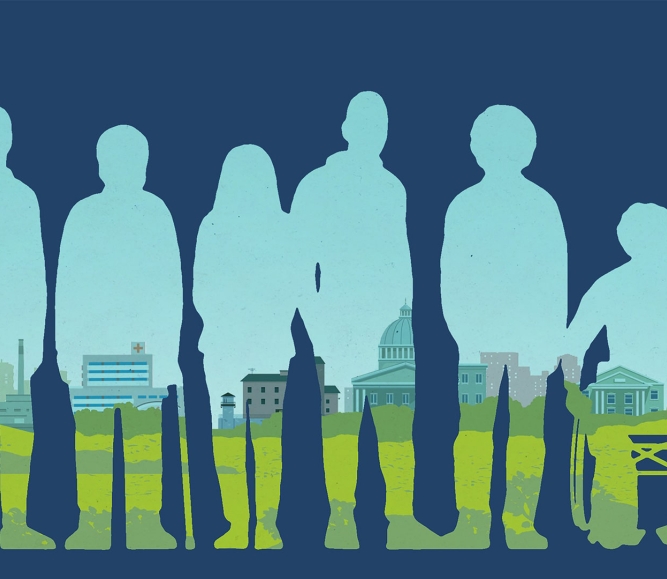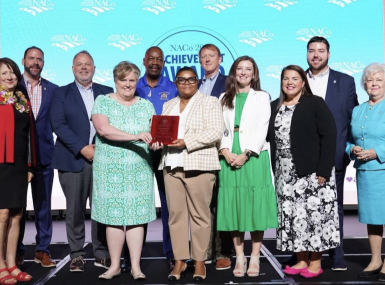Rural counties are ‘Stepping Up’

Key Takeaways
Codington County is a geographically large rural county with a population of about 25,000 in eastern South Dakota. The County Board of Commissioners passed a Stepping Up resolution in June 2015. Commissioner D. Lee Gabel from District 1 was interviewed shortly after passing a resolution about the county’s intentions with the initiative.
Why did Codington County pass a Stepping Up resolution?
Codington County has been facing a number of challenges recently with our court caseload and jail population. We have an aging and small jail that is not meeting the needs of our county. The state has really begun to focus on reducing the state penitentiary population, so criminal justice reform is on everyone’s mind here. So in that context, there was already some political will to do something. When Stepping Up highlighted the issue of mental illness in jail, my fellow commissioners and I were receptive. Our welfare director did her homework and suggested the Stepping Up resolution to the Board with support of the sheriff. The initiative seemed like it would help us address some of our challenges in our jail. After some discussion, we adopted the resolution unanimously.
Was there any disagreement or pushback about joining the initiative?
Because of the problems we are facing with our jail and the population, we didn’t face a lot of opposition to getting involved. I was concerned about passing a resolution with only good intentions, but once I understood the resources that were available to us through the initiative — all of the webinars and other tools — I was persuaded. We wanted to make sure that passing this resolution was going to result in real work being done to address this issue, and it has so far.
What has Codington County been doing to address this issue since passing the Stepping Up resolution?
We are very fortunate to have someone in our county — our welfare director — who has been able to really focus on this issue and help move things forward with the initiative. We have developed a small Stepping Up working group consisting of myself, the welfare director, the sheriff, the chief corrections officer, the community mental health center and our new jail mental health professional.
As a result of having access to expertise through Stepping Up, we were able to quickly identify an action that we could take immediately to get the initiative moving. We hired a part-time mental health professional to provide services at the jail. He works 20 hours per week and both the staff and the inmates at the jail have already responded well to having him on site. Anecdotally, he sees about eight inmates a day, which also shows us the extent to which this is a problem in our jail.
We are currently in the process of trying to better identify people with mental illnesses who come into the jail by researching screening tools and strategizing ways to best systematize this process. We want to make the process efficient and effective, while collecting data and developing outcome measures to accurately understand our efforts. We have already seen some positive results, but we want the data to show it and to help guide us in our next steps.
What are you hoping to do through Stepping Up and beyond?
The end goal is really to have a well-operating system that is able to effectively identify people with mental illnesses who come into the jail and have options available to ensure that only the people who need to be in the jail are detained there and those who don’t can be connected to services in the community. We are currently working to bring in additional stakeholders to help meet this need.
We would also like to minimize the time that individuals spend in our jail pretrial, and provide them with the services they need to ensure that they are better connected to the community once they leave. We want to effectively use our resources for the individuals who need them most. We know that this process is going to take some time, but we are willing to put in the time to do it right.
Featured Initiative
The Stepping Up Initiative
The Stepping Up Initiative is a data-driven framework that aims to reduce the overincarceration of people with mental illnesses in jails through training, resources, and support that are tailored to local needs.

Related News

Deadline approaching for children’s summer nutrition program
Deadline approaching for children’s summer nutrition program

North Carolina county decreases 911 non-emergency calls by connecting residents to services they need
Guilford County, N.C. was inundated with 911 calls until the county connected residents to resources, including primary care physicians and access to food, so they don’t feel the need to call an emergency line.
King County school offers students a route to sobriety
The Interagency Recovery Campus, funded in part by King County, Wash. Behavioral Health and Recovery, fosters an environment to support students' paths to sobriety.
